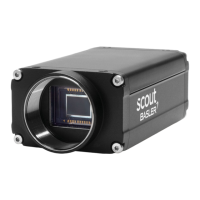AW00011916000 Camera Functional Description
Basler scout GigE 73
6.2 Overview (scA750-60 Only)
Each camera provides features such as a full frame shutter and electronic exposure time control.
The sensor chip includes gain controls, ADCs, and other digital devices.
Exposure start, exposure time, and charge readout can be controlled by parameters transmitted to
the camera via the Basler pylon API and the GigE interface. There are also parameters available
to set the camera for single frame acquisition or continuous frame acquisition.
Exposure start can also be controlled via an externally generated hardware trigger (ExTrig) signal.
The ExTrig signal facilitates periodic or non-periodic acquisition start. Exposure can be set for a
preprogrammed period of time.
Accumulated charges are read out when the programmed exposure time ends. At readout, the
accumulated charges are transported from the sensor’s light-sensitive elements (pixels) to the
sensor’s column buses (see Figure 32 on page 72). The charges from the bottom line of pixels in
the array are then moved into the analog processing section of the sensor. As the charges move
from the pixels to the analog processing section, they are converted to voltages proportional to the
size of each charge. The voltages from the analog processing section are next passed to a bank of
Analog-to-Digital converters (ADCs).
Finally, the voltages pass through a section of the sensor where they receive additional digital
processing and then they are moved out of the sensor. As each voltage leaves the sensor, it passes
through an FPGA and into an image buffer. All shifting is clocked according to the camera’s internal
data rate. Shifting continues in a linewise fashion until all image data has been read out of the
sensor.
The pixel data leaves the image buffer and passes back through the FPGA to an Ethernet controller
where it is assembled into data packets. The packets are then transmitted via an Ethernet network
to a network adapter in the host PC. The Ethernet controller also handles transmission and receipt
of control data such as changes to the camera’s parameters.
The image buffer between the sensor and the Ethernet controller allows data to be read out of the
sensor at a rate that is independent of the data transmission rate between the camera and the host
computer. This ensures that the data transmission rate has no influence on image quality.
The information in this section only applies to scA750-60 gm/gc cameras. For
information about the other camera models, see Section 6.1 on page 71.

